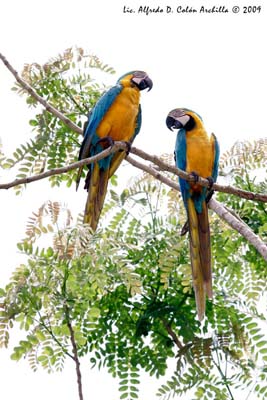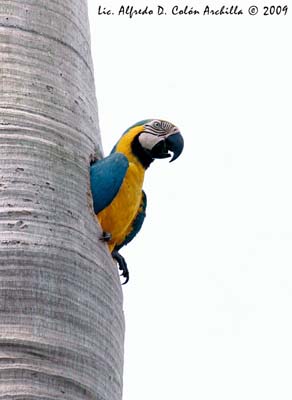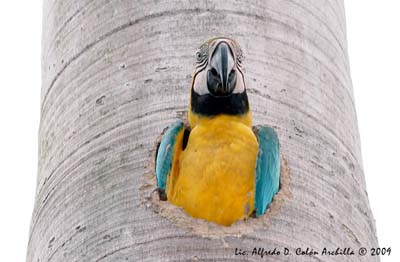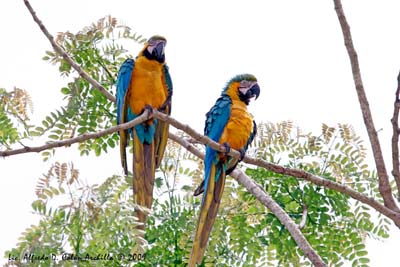
Blue-and-yellow Macaw
Ara ararauna
Psittaciforme Order – Psittacidae Family
BIOMETRICS:
Length: 86-92 cm
Wingspan: 104-114 cm
Weight: 995-1380 g
LONGEVITY: up to 60 years
DESCRIPTION:
Blue-and-yellow Macaw is a popular cage bird, due to its sticking appearance and its ability for talking.

Adult has blue upperparts, including hind crown, wings and tail.
On the underparts, chin and throat are black. Neck sides, breast, belly and vent are golden yellow. Underwing coverts are yellow, with duller flight feathers. Undertail coverts are blue. Graduated tail is gold with buff-tipped feathers.
On the head, fore crown and top of the crown are green. Blue-and-yellow Macaw has white lores and face, with fine lines of short black feathers. White face can become pink when bird is excited.
Strong, hooked bill is blackish. Eyes are yellow. Legs and feet are dark grey.
Both sexes are similar.
Juvenile resembles adults, but it has shorter tail, and its eyes are grey. It reaches its sexual maturity at 3 or 4 years of age.
VOICE: SOUNDS BY XENO-CANTO
Blue-and-yellow Macaw gives loud, guttural “rraa-aaar” or “kurr-raak”. These calls are uttered with quavering tone. Their shrill calls can be heard over long distances.
HABITAT:
Blue-and-yellow Macaw lives in seasonally flooded forests, mainly at edges, also in gallery forests along streams, savannahs with scattered trees and palm swamps. It can also be found in deciduous woodlands away from water. It can live from lowlands to 500 metres in most parts of the range, but occasionally to 1500 metres in Peru.
RANGE:
Blue-and-yellow Macaw lives and breeds in tropical South America, from Panama, and southwards to Brazil, Bolivia, Uruguay and Trinidad, where the species is endangered.
BEHAVIOUR:
Blue-and-yellow Macaw feeds mainly in trees. Its diet includes fruits, berries, seeds, nuts and flowers. As other macaws, its powerful beak allows it to break open nut’s shells.
Bill is also as a “third foot”, used for climbing in trees, or hanging to branches.
Blue-and-yellow Macaw is a gregarious bird. It is often seen in pairs, small family groups or up to 20 to 30 birds. Larger flocks congregate at clay-licks in riverbanks. They are noisy and conspicuous when they move between their roosts and feeding areas.

Blue-and-yellow Macaw performs destructive chewing to bark or other plant matter. They can travel long distances for feeding, and young bids follow the adults, in order to learn how to find food. In open areas, they can feed on ground, by picking fallen nuts, but they feed mainly in treetops where they are protected.
Blue-and-yellow Macaw is resident in its range. It performs some seasonal movements in rainy season, and daily long-distance flights between communal roosts and feeding areas.
FLIGHT:
Blue-and-yellow Macaw has direct flight, and performs slow, shallow wing beats. Both mates of a pair fly close to each other, almost touching their wingtips, making them easy to recognize within large flock.
REPRODUCTION:
Breeding season varies according to the location.
Blue-and-yellow Macaw nests in cavities, in holes in dead tall palm trees, fairly high above the ground. Pairs probably mate for life.
Female lays two eggs, occasionally three. Incubation lasts about 24 to 26 days, mainly by female. But both adults protect and defend the nest-site aggressively.
Altricial chicks hatch blind and naked. Usually, only the strongest survives, and the others die by starvation.
Young needs at least 10 to 13 weeks to develop full plumage. After fledging, it remains with parents for several months more, before to become independent.

DIET:
Blue-and-yellow Macaw, as other macaws, eats clay and minerals on riverbanks. These macaws feed on several plant species, including toxic plants. To eat clay allows them to digest the poisonous contained into fruits and seeds of these plants.
But usually, Blue-and-yellow Macaw feeds on fruits or some parts of them, nuts, berries, blooms, leaves, and flowers of Combretum. Its favourite seeds come from Hura crepitans trees.

PROTECTION / THREATS / STATUS:
Blue-and-yellow Macaws are threatened by habitat loss for agriculture. Collect of birds, young and adults, for trade to Europe and North America has serious effect on populations in wild.
Blue-and-yellow Macaw’s predators are birds of prey such as Harpy Eagle, Hawk Eagle and Orange-breasted Falcon. They can attack macaws when in flight.
Programs of conservation include building of artificial nests, because competition for cavities is a threat more for this species.
Bird specialists also try to remove the second chick from the nest, in order to raise it instead to leave it to die by starvation.
However, Blue-and-yellow Macaw populations are not listed as endangered, but they are in real decline in some parts of the range.
Fr: Ara bleu
All : Ararauna
Esp : Guacamayo Azulamarillo
Ital : Ara ararauna
Nd : Blauwgele Ara
Russe : Синежёлтый ара
Photographs by Alfredo Colón
Puerto Rico Wildlife
Text by Nicole Bouglouan
Sources:
HANDBOOK OF THE BIRDS OF THE WORLD vol 4 by Josep del Hoyo-Andrew Elliott-Jordi Sargatal - Lynx Edicions - ISBN: 8487334229
PARROTS OF THE WORLD – An Identification Guide – by Joseph M. Forshaw – Princeton University Press – ISBN 0691092516
Wikipedia (Wikipedia, The Free Encyclopedia)
Arthur Grosset's Birds (Arthur Grosset)